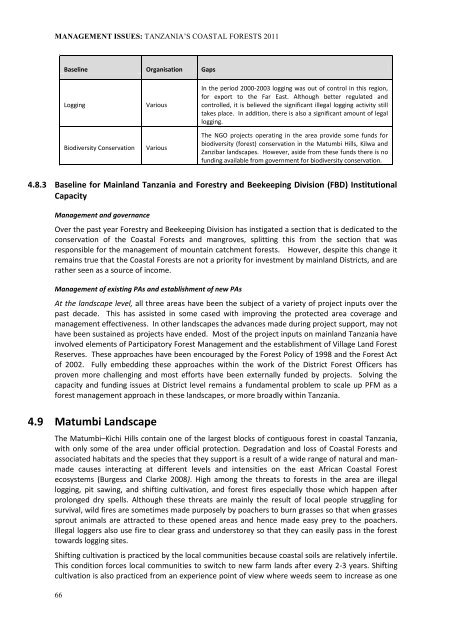Neil D. Burgess, Paul Harrison, Peter Sumbi, James Laizer, Adam ...
Neil D. Burgess, Paul Harrison, Peter Sumbi, James Laizer, Adam ...
Neil D. Burgess, Paul Harrison, Peter Sumbi, James Laizer, Adam ...
Create successful ePaper yourself
Turn your PDF publications into a flip-book with our unique Google optimized e-Paper software.
MANAGEMENT ISSUES: TANZANIA’S COASTAL FORESTS 2011<br />
Baseline Organisation Gaps<br />
Logging<br />
Biodiversity Conservation<br />
Various<br />
Various<br />
In the period 2000-2003 logging was out of control in this region,<br />
for export to the Far East. Although better regulated and<br />
controlled, it is believed the significant illegal logging activity still<br />
takes place. In addition, there is also a significant amount of legal<br />
logging.<br />
The NGO projects operating in the area provide some funds for<br />
biodiversity (forest) conservation in the Matumbi Hills, Kilwa and<br />
Zanzibar landscapes. However, aside from these funds there is no<br />
funding available from government for biodiversity conservation.<br />
4.8.3 Baseline for Mainland Tanzania and Forestry and Beekeeping Division (FBD) Institutional<br />
Capacity<br />
Management and governance<br />
Over the past year Forestry and Beekeeping Division has instigated a section that is dedicated to the<br />
conservation of the Coastal Forests and mangroves, splitting this from the section that was<br />
responsible for the management of mountain catchment forests. However, despite this change it<br />
remains true that the Coastal Forests are not a priority for investment by mainland Districts, and are<br />
rather seen as a source of income.<br />
Management of existing PAs and establishment of new PAs<br />
At the landscape level, all three areas have been the subject of a variety of project inputs over the<br />
past decade. This has assisted in some cased with improving the protected area coverage and<br />
management effectiveness. In other landscapes the advances made during project support, may not<br />
have been sustained as projects have ended. Most of the project inputs on mainland Tanzania have<br />
involved elements of Participatory Forest Management and the establishment of Village Land Forest<br />
Reserves. These approaches have been encouraged by the Forest Policy of 1998 and the Forest Act<br />
of 2002. Fully embedding these approaches within the work of the District Forest Officers has<br />
proven more challenging and most efforts have been externally funded by projects. Solving the<br />
capacity and funding issues at District level remains a fundamental problem to scale up PFM as a<br />
forest management approach in these landscapes, or more broadly within Tanzania.<br />
4.9 Matumbi Landscape<br />
The Matumbi–Kichi Hills contain one of the largest blocks of contiguous forest in coastal Tanzania,<br />
with only some of the area under official protection. Degradation and loss of Coastal Forests and<br />
associated habitats and the species that they support is a result of a wide range of natural and manmade<br />
causes interacting at different levels and intensities on the east African Coastal Forest<br />
ecosystems (<strong>Burgess</strong> and Clarke 2008). High among the threats to forests in the area are illegal<br />
logging, pit sawing, and shifting cultivation, and forest fires especially those which happen after<br />
prolonged dry spells. Although these threats are mainly the result of local people struggling for<br />
survival, wild fires are sometimes made purposely by poachers to burn grasses so that when grasses<br />
sprout animals are attracted to these opened areas and hence made easy prey to the poachers.<br />
Illegal loggers also use fire to clear grass and understorey so that they can easily pass in the forest<br />
towards logging sites.<br />
Shifting cultivation is practiced by the local communities because coastal soils are relatively infertile.<br />
This condition forces local communities to switch to new farm lands after every 2-3 years. Shifting<br />
cultivation is also practiced from an experience point of view where weeds seem to increase as one<br />
66

















